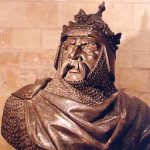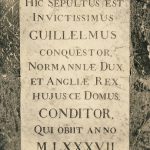William the Conqueror
The reign of William the Conqueror (1035-1087) traditionally appears as a prosperous period for the duchy of Normandy.
William grows his ancestors’ past alliances and develops new ones, imposing himself as a territorial prince with international reputation.
In 1066 , he is officially crowned king of England, December 25 in Westminster Abbey, based upon a long-standing Anglo-Norman marriage alliance.
William is one of those sea princes of 11th century, as the Danish King Knut the Great, who, revisiting the legacy of their Viking ancestors in a more political perspective, succeeds with a powerful fleet to conquer an empire and to keep it, attempting to develop institutions and a strong administrative apparatus.
In 1085, he ordered the creation of a large inventory of territories and possessions of each lord in England : the Domesday Book, manuscript comprising two volumes: Great Domesday (general account of British territories except Suffolk, Norfolk and Essex ) and Little Domesday (general account territories of Norfolk , Suffolk and Essex), whose goal is to identify for future taxes, record tenures (and their changes) after 19 years of Norman rules and to solve conflicts by the recognition of acquired land.
In July 1087, Guillaume attacked the territory of Vexin, was wounded in the battle and brought back dying to Rouen.
He made donations to churches, appointed his eldest son Robert, his successor at the head of the Duchy of Normandy and gave William, his second son, England without naming him king directly. Finally he gave his third son Henry money.
William died September 9, 1087. He is buried at Caen in the Abbaye-aux-Hommes and his wife Matilda in the Abbaye-aux-Dames in 1083 .
View 9 : marble slab marking the grave of William the Conqueror at the Abbaye-aux-Hommes in Caen, with the latin inscription :
HIC SEPULTUS EST
INVICTISSIMUS
GUILLELMUS
CONQUESTOR
NORMANNIÆ DUX
ET ANGLIÆ REX
HUJUSCE DOMUS
CONDITOR
QUI OBIIT ANNO
MLXXXVII
Translated by : « Here lies the invincible William the Conqueror, Duke of Normandy and King of England, founder of the house, who died the year 1087».
For further details :
– “William the Conqueror” (2011) by David Bates
– “Gesta Normannorum Ducum” (1070-1071) by Guillaume de Jumièges
– “Guillelmi Ducis Normannorum et Regis Anglorum” (1077) by Guillaume de Poitiers
– “Ecclesiasical History” (1141) by Orderic Vitalis
– “De Gestis Regum Anglorum” (1125) by Guillaume de Malmesbury
– “Carmen de Hastinage proelio” (written 3 years after the battle)
– “Anglo-Saxon Chronicles” (late 9th c.) : out of the 9 manuscripts, 7 are preserved at the British Library in London, one in Oxford, and the last one in Cambridge.
– Tapestry of Bayeux
– charters, for an institutional point of view
– Domesday Book, inventory of lands and depiction of England after 1066.
- Origin
Falaise
- Institution
Archives départementales de Seine – Maritime
- Original reference
74 Fi 3/5
- Period
Middle Age
- Thematic
Politic and military links
Rouen – Archives Départementales









